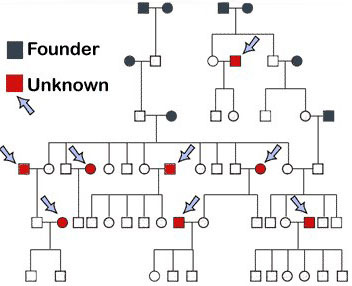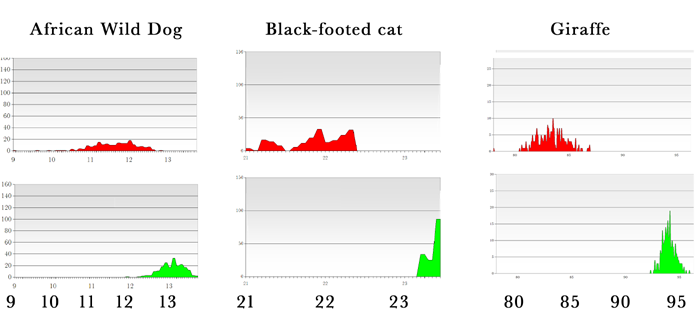2. Categorise unknown parents

Necessity for the next step
When founders are not identified, and all animals without registered parents are regarded as founders, the genetic diversity might look much higher than it actually is. The tools presented in step 3 will therefore promote the wrong animals, due to unidentified relations within the population. It is even better to do nothing then use Mean Kinship when this problem is not tackled.
Founders
Founders are simply defined as animals that are unrelated to each other. All pedigree end up in the founder animals. Founders are animals that belonged to the ‘source population’. In zoo-populations these are the animals that were caught from the wild. For example, the number of founders of the global captive Red Panda (Ailurus fulgens) population is 35. In domestic breeds the founders might sometimes be more difficult to identify. However, many dog breeds started with only a few founders, making it easier to identify them. For the Icelandic Sheepdog the number of founders was no more than 20. The place of origin of these animals are known for most of these 20 founders.
Two or three categories
All animals without parents registered should be assigned to the following categories:
1) Founders (true founders are unrelated to all other founders)
2) Foundlings: animals that descent from founders but without known parents
3) Unknown: animals of which there is no idea at all where they came from
Only use “Unknown” if animals have a high chance of being a founder, otherwise don’t put an animal into this category.
For founders it is important to get their background story. For wild-caught animals the place of origin is important as well as the (suspected) subspecies of this animal. In breeds, it is also handy to add a note per founder. Moreover, sometimes other breeds are introduced into the population. These animals are also ‘founder-animals’.
If possible one should identify possible parents for ‘Foundlings’. In step 3 we can make use of that information. In advanced kinship calculation software the probable parents of Foundlings are incorporated. Conservation strategies based on these kinship calculations are more effective then looking at inbreeding.
How to categorise animals with unknown parents?
As in the previous step, for this you need to find someone that is experienced in databases. In larger datasets with a high number of parents with unknown parents, it is advisable to ‘clean’ animals that did not contribute to the current population, before you start identifying founders and probable parents.
Necessity for next step
When founders are not identified than all animals with unknown parents are assumed to be founders when kinship is calculated. Analysis based on incomplete pedigrees might even have negative effect on breeding decisions: it might reduce diversity. In a study of three populations having unregistered parents, the effect of not identifying founders was investigated. The results were published in my thesis. An indication of the effect is shown below. The figure shows diversity saved by simulations based on existing pedigrees where animals with unknown parents were not corrected (red area; the upper graph) or corrected by probable parents (green area; the lower graph). Simulations were based on existing pedigrees of three zoo-populations. The diversity saved was much higher in each population when true founders and probable parent for Foundlings were identified. As an example: in giraffe 95 Founder genome equivalents (a gene-diversity measure) was saved instead of only 84. Within conservation genetics these are enormous amounts.

